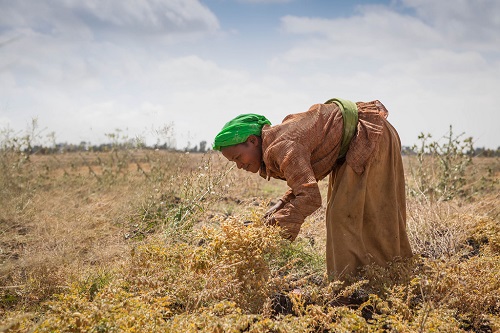Swathi Sridharan photo
By
Abebe Wolde Giorgis
Conventional farming methods that utilize agricultural inputs such as selective seeds which have a capacity to resist drought, diseases and pest help to raise productivity. In addition to these, fertilizer and pesticide support to get more yield per hectare.
In utilizing improved seeds and other inputs the role of research institutions is critical. In such venture the Ethiopian Agricultural Research Institute (EIAR), Bishoftu branch played a crucial role since its establishment. Based on the needs of the farmers, it continues to provide farming technologies and training to farmers, the institute to date producing and disseminating to farmers 18 types of chickpeas.
Recently, during a field visit the EIAR Bishoftu branch Director Dr Solomon Chanyalew said that the institute will continue reaching farmers through the provision of selected seeds and farming technology and warned that farmers should only purchase selected seeds from the associations which have a legal license to duplicate the original seed provided by the EIAR and other government institutions which engaged in agricultural research work. Previously some illegal organizations arbitrarily disseminated unqualified and unrecognized seeds to farmers for sowing but never brought a better outcome, as a result, farmers payed a heavy price by such misdeed. Hence to avoid such circumstances farmers should only purchase seeds from legal seed duplicator associations which are legally abided.
Nigusie Girma is the team leader of the crop research department in the EIAR Beshoftu branch and according to him, in order to address the scarcity of seeds used for sowing the institute made tremendous efforts with the collaboration of USAID and ICARDA. The institute with the program of Community Based Sediment Duplication produced selected seeds but before it developed improved chickpea seeds it assessed the seed, agro ecology, type of soil and moisture of the farm where it could be planted.
Currently the institute works with two local seed duplicating associations known locally as “Megertu” and “Gichi Garababo”. The associations organized themselves by cluster and 9 males and 4 females engaged in duplicating chickpea seeds. The members work together in land preparation, sowing, removing herbs, following up plants and harvesting.
Alemu Tessema is the Chair Person of the “Megertu” seed duplicating association and according to him the EIAR Bishoftu branch supported them to change their traditional way of farming into the modern one, the result of which being they could double their crop productivity per hectare and by now, after satisfying their own needs, could supply the selected chickpea to farmers.
Abera Ashene is the Chairman of the Gichi Garababo seed duplicating association who stated that the association members produced improved seeds by 7 hectares of land and last August planted the improved chickpeas for duplication in 2.4 hectares by 23 coupled oxen farming. The members of the clusters planted the seed in a lining system.
Beforehand, the quality of the seed was experimented by the laboratory and inspected by the Woreda extension workers and after it got the green light from the official to be reproduced, was planted. The association has 74 members and by the next harvest season, they expect to produce 60 quint per hectare.
According to Nigusie Girma, chickpeas in Ethiopia usually grew in the mid highlands next to beans and soybeans and the area from 1,500 meters up to 2,600 meters above sea level was said to be conducive to the crop and if it is supported by irrigation, could be produced in the area below 1,500 meters above sea level.
The crop is mostly sown in black soil and does not need the utilization of fertilizer, the preferred plowing and sowing chickpea season being from the month of August up to the beginning of September. But in the places where scarcity of rain is prevailed, sowing the crop in the month of July is best. To protect the crop from herb farmers after the mushrooming of the seedling within 60 days, the herbs have to be removed at least twice and if protected in such manner, enhancing productivity should be possible.
As per Nigusie, chickpeas could be threatened by pests, so to minimize and avoid the risk, farmers have to employ various measures. They must first purchase clean sowing crops free from disease and have to utilize a crop shifting mechanism. However, if pests emerge, they should apply 1 kilo of Dakonile chemical mixing with 200 litres of water per hectare.
Currently the nation strives to enhance agricultural production and productivity to supply to domestic as well as foreign markets. So many technologies helpful to enhance chickpea productivity disseminated by EIAR to the farmers and such practices brought better results. In 2007 the productivity of chickpea per hectare was 8.9 quint but by now it rose to 19.1 quint per hectare.
By now, in the global market the demand for chickpea has been rising from time to time particularly its demand in the Indian market increasing. In 2009 4586822.55 quint chickpea were produced in Ethiopia, 74.4 percent of which was consumed locally while 25.6 exported to overseas markets.
As Ethiopia has an agricultural dominated economy, maximizing agriculture production helps the nation to attain food security and reduce poverty. It also boosts the export market essential for earning badly needed hard currency and for that, the role of agricultural research institutions is essential.
Abebe Wolde Giorgis
Abebe Wolde Giorgis was born in Harar, Ethiopia. He has a B.A from Addis Ababa University in English Language and Literature, Minor History.
For 17 years he has been a Journalist in local and International Media, Amharic and also an English Newspaper.He wrote several articles on environment and economics.
Member of Environment journalist association, he was deputy editor in chief of an Amharic Newspaper and Senior Editor of the Ethiopian Herald.



No Comments Yet!
You can be first to comment this post!